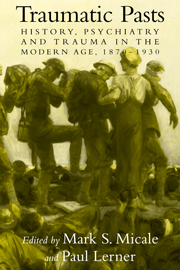Book contents
- Frontmatter
- Contents
- Contributors
- Preface
- 1 Trauma, Psychiatry, and History: A Conceptual and Historiographical Introduction
- Part One Travel and Trauma in the Victorian Era
- 2 The Railway Accident: Trains, Trauma, and Technological Crises in Nineteenth-Century Britain
- 3 Trains and Trauma in the American Gilded Age
- Part Two Work, Accidents, and Trauma in the Early Welfare State
- Part Three Theorizing Trauma: Psychiatry and Modernity at the Turn of the Century
- Part Four Shock, Trauma, and Psychiatry in the First World War
- Index
- Titles in the series
3 - Trains and Trauma in the American Gilded Age
Published online by Cambridge University Press: 14 October 2009
- Frontmatter
- Contents
- Contributors
- Preface
- 1 Trauma, Psychiatry, and History: A Conceptual and Historiographical Introduction
- Part One Travel and Trauma in the Victorian Era
- 2 The Railway Accident: Trains, Trauma, and Technological Crises in Nineteenth-Century Britain
- 3 Trains and Trauma in the American Gilded Age
- Part Two Work, Accidents, and Trauma in the Early Welfare State
- Part Three Theorizing Trauma: Psychiatry and Modernity at the Turn of the Century
- Part Four Shock, Trauma, and Psychiatry in the First World War
- Index
- Titles in the series
Summary
As Ralph Harrington argued in the previous chapter, modern travel, not modern warfare, engendered a novel and hitherto unfathomable ailment, the railway spine. Having gestated for more than a decade, this once unheard of ailment came to life in the spring of 1866. Initially regarded as an exclusively somatic disease, railway spine entered its adolescence in the 1880s as a confusing psychical ailment, began its adulthood in the 1890s in a state of somatic-psychic flux, and suffered an early death in the first decade of the twentieth century. In its short life, railway spine contributed to a fundamental restructuring of the somatic paradigm and to a novel awareness of the capacity of traumatic experience to engender a wide array of physical and psychical symptoms.
Railroad tracks in the United States had grown from 3,000 miles in 1840 to almost 52,000 in 1872. Such a rapid burgeoning was by no means an unmitigated blessing. With the expansion came accidents, injuries, and death. Historian Walter Licht reports that for every 117 trainmen employed in the United States in 1889, one was killed; for every twelve, one was injured. Workers and their families were not the only parties to be adversely affected; passengers and bystanders were also at risk. Although the majority of trainwreck victims experienced commonly expected ailments like broken bones, concussions, and contusions, other apparent victims appeared to escape physically unscathed. But some who literally had walked away from a high-speed wreckage soon found themselves displaying a host of seemingly inexplicable symptoms.
- Type
- Chapter
- Information
- Traumatic PastsHistory, Psychiatry, and Trauma in the Modern Age, 1870–1930, pp. 57 - 78Publisher: Cambridge University PressPrint publication year: 2001
- 7
- Cited by

